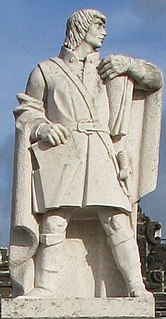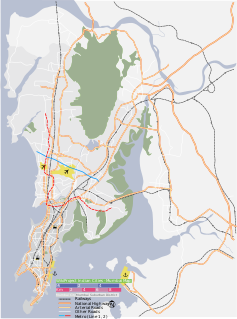
Aristides de Sousa Mendes do Amaral e Abranches GCC, OL was a Portuguese consul during World War II.

The Captaincies of Brazil were captaincies of the Portuguese Empire, administrative divisions and hereditary fiefs of Portugal in the colony of Terra de Santa Cruz, later called Brazil, on the Atlantic coast of northeastern South America. Each was granted to a single donee, a Portuguese nobleman who was given the title captain General. Except for two, São Vicente and Pernambuco, they were administrative and economic failures. They were effectively subsumed by the Governorates General and the States of Brazil and Maranhão starting in 1549, and the last of the privately granted captaincies reverted to the Crown in 1754. Their final boundaries in the latter half of the eighteenth century became the basis for the provinces of Brazil.

The seven islands of Bombay were 16th-century Portuguese territories lying off the west coast of India, that were handed over to England under this title as part of the dowry of Catherine of Braganza when she married Charles II in 1661.The isles had earlier been part of indigenous empires like the Silhara dynasty and the Sultan of Gujarat before they were captured by the Portuguese in 1534. After acquiring them as dowry, Charles II rented the islands to the East India Company in 1668 for £10 a year. By 1845, the islands had been merged into one landmass by means of multiple land reclamation projects. The resulting island of Bombay was later merged with the nearby islands of Trombay and Salsette that lay to its North-east and North respectively to form Greater Bombay. These islands now constitute the southern part of the city of Mumbai.

Salsette Island (Salsete) is an island in the state of Maharashtra on India's west coast. The metropolis of Mumbai and the city of Thane lie on it, making it very populous and one of the most densely populated islands in the world. It has about 15.1 million inhabitants living on an area of about 619 km².

João Gonçalves Zarco was a Portuguese explorer who established settlements and recognition of the Madeira Islands, and was appointed first captain of Funchal by Henry the Navigator.

Gonçalo Velho Cabral was a Portuguese monk and Commander in the Order of Christ, explorer and hereditary landowner responsible for administering Crown lands on the same islands, during the Portuguese Age of Discovery.

Fort Bassein, also known as the Vasai Fort or Fort Baçaim, is a large fort in the town of Vasai in the Palghar district of Maharashtra state in the Konkan division in India. The name "Bassein" is the English version of the Portuguese "Baçaim", itself a version of an apparently native name that may have a connection to the Vasa Konkani tribals of the North Konkan region, extending from Mumbai into "South Gujarat". The Marathi name of the place is Vasai.

The Mazagaon Fort was a British fort in Mazagaon, Bombay, in the Indian state of Maharashtra, built around 1680. The fort was razed by the Muslim Koli general, Yakut Khan in June 1690. The fort was located at the present-day Joseph Baptista Gardens, atop Bhandarwada Hill outside the Dockyard Road railway station.
The highest hereditary title in the Portuguese monarchy. By tradition, there are a total of five royal and seven non-royal dukes in Portugal, out of 28 dukedoms that have ever been created. In the majority of cases, the title of duke was attributed to members of the high nobility, usually relatives of the Portuguese Royal Family, such as the second son of a monarch.
The Treaty of Bassein was signed by Sultan Bahadur of Gujarat and the Kingdom of Portugal on 23 December 1534 while on board the galleon São Mateus. Based on the terms of the agreement, the Portuguese Empire gained control of the city of Bassein, as well as its territories, islands, and seas. The Mumbai islands which fell under Portuguese control included Colaba, Old Woman's Island, Mumbai, Mazagaon, Worli, Matunga, and Mahim. Salsette, Daman and Diu, Thane, Kalyan, and Chaul were other territories controlled and settled by the Portuguese.

The Castelo da Póvoa, also Fortress of Póvoa de Varzim, officially Fortaleza da Nossa Senhora da Conceição or Nossa Senhora da Conceição Fortress, is a Portuguese fortress in Póvoa de Varzim rebuilt during the reigns of Peter II and John V to defend the town from privateers, in the site of an earlier fort known as "Forte de Torrão". It is considered a listed property of Public Interest in Portugal.

Henrique Teixeira de Sousa was a doctor and author from Cape Verde.

Duke of Lafões was a Portuguese title of nobility created under the decree of February 17, 1718, of King John V of Portugal and granted to his nephew, Dom Pedro Henrique de Bragança, son of the Infante Miguel de Bragança, an illegitimate son of King Peter II of Portugal and Anne Armande Pastre de Verger, though Pedro's mother, Luisa Casimira de Sousa Nassau e Ligne was the first to use this title.The title was later passed on to his brother, João Carlos de Bragança e Ligne de Sousa Tavares Mascarenhas da Silva, the most famous Duke of this title.
Count of Vimioso is a Portuguese title of nobility which have its origins in Alphonse, Bishop of Évora, the natural son of Alphonse, 4th Count of Ourém and 1st Marquis of Valença. Therefore, the Counts of Vimioso were closely related to the Braganzas.

Bombay, now called Mumbai, Bombaim in Portuguese, is the financial and commercial capital of India and one of the most populous cities in the world. At the time of arrival of the Portuguese, current Bombay was an archipelago of seven islands. Between the third century BCE and 1348, the islands came under the control of successive Hindu dynasties. The Muslim rulers of Gujarat, who had been ruling current Thane and Vasai for a few decades, annexed the islands in 1348, that were later governed by the Gujarat Sultanate from 1391 to 1534. Growing apprehensive of the power of the Mughal emperor Humayun, Sultan Bahadur Shah of the Gujarat Sultanate was obliged to sign the Treaty of Bassein with the Portuguese Empire on 23 December 1534. According to the treaty, the seven islands of Bombay, the nearby strategic town of Bassein and its dependencies were offered to the Portuguese. The territories were later surrendered on 25 October 1535.

Count of Vila Real was a Portuguese title of nobility created by a royal decree, in 1424, by King John I of Portugal, and granted to Dom Pedro de Menezes, also known as Peter I of Menezes, 1st Count of Viana.

Gloria Church is built in 1911-13 on one of the oldest Roman Catholic church sites in Mumbai; its predecessor was built by the Portuguese Franciscans in 1632. The church is situated in the Byculla, Mumbai.

Pedro de Araújo Lima, Marquis of Olinda was a politician and monarchist of the Empire of Brazil. His long political career expanded through the reigns of João VI, Pedro I and Pedro II. He was also one of the founders of the Brazilian Conservative Party.

Venceslau de Sousa Pereira de Lima, ComTe, GCTE, ComSE, GCSE, ComC, GCC, ComNSC, GCNSC, also known as Venceslau de Lima and anglicized as Wenceslau de Sousa Pereira de Lima or Wenceslau de Lima, was a Portuguese geologist, paleontologist, viticulturist, and politician who, among other functions, served as a member of Parliament, a minister, and as President of the Council of Ministers. He was a member of the Sciences Academy of Lisbon.

















